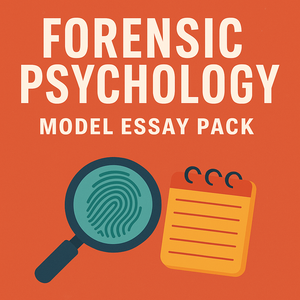Struggling with Schizophrenia Essays in AQA Psychology? Here's How to Get It Right
If you're studying AQA A-Level Psychology, chances are the word "schizophrenia" makes your stomach turn a little. It's one of the more complex topics on the specification, packed with challenging terminology, confusing biological processes, and lots of tricky evaluation. And when it comes to the 16-mark essay questions? That's where many students start to feel overwhelmed.
In this article, we'll explore the most common struggles psychology students face when writing schizophrenia essays and provide practical solutions to help you succeed. Whether you're aiming for a C or chasing that elusive A*, there's one key secret: it's not about writing more, it's about writing smarter.
Why Schizophrenia Trips Up So Many Students
The topic of schizophrenia covers a wide range of content: biological explanations, psychological explanations, treatments, issues with diagnosis, and more. But it's not just the content itself that’s difficult—it’s how you structure your response, hit the assessment objectives (AO1, AO2, AO3), and stay focused on the question.
Here are the top 3 issues students face:
1. Getting lost in AO1
Many students spend too much time writing everything they know about schizophrenia, especially biological explanations like the dopamine hypothesis or genetic evidence. The problem? AQA only awards 6 marks for AO1 in a 16-marker. That means you need to be selective—only include what's most relevant.
2. Weak or missing evaluation
Evaluation is where most marks lie in a 16-mark essay (typically 10 marks for AO3). Yet many students either forget to evaluate properly or rely on vague, generic phrases like "this study is outdated" or "this might not be valid." To score highly, your AO3 needs to be structured, specific, and show clear understanding.
3. Poor structure and missing application
Students often mix up points, skip AO2 application, or forget to include counterarguments. This leads to a disorganised response that feels more like a brain dump than a high-level essay. And when application is required (as it often is), it’s easy to forget how to link the theory to a real-life example.
So, How Do You Write a Killer Schizophrenia Essay?
Let’s break it down.
Start with Smart AO1
AO1 is about knowledge and understanding. You only need around 6 marks’ worth—roughly one paragraph per explanation. Focus on key terms (e.g. dopamine, mesolimbic pathway, enlarged ventricles), name specific researchers (e.g. Gottesman, Joseph), and keep it focused on what the question is asking. If the question is about biological explanations, don’t waste time on psychological ones.
Structure Your Evaluation Using PBWC
At Yum Yum Mama, we teach students to use the PBWC structure for evaluation:
-
Point (state the strength or limitation)
-
Because (give a reason or supporting evidence)
-
Why (explain the wider importance or implication)
-
Counterpoint (give a limitation/strength of that point or an alternative view)
This structure ensures your AO3 is full, focused, and balanced. Plus, it shows the examiner you're engaging in discussion—not just listing strengths.
Include Application When Needed
When a question includes a stem or scenario (e.g. someone like Jade or Jay being described), that’s your cue to apply theory to real life. Mention how symptoms like hallucinations or avolition can be explained by dopamine dysfunction or high expressed emotion. Don’t just describe schizophrenia—apply your knowledge to the case.
Use Mnemonics to Jog Your Memory
Trying to memorise entire essays can feel impossible. Instead, use short memory tricks. Here are two favourites:
-
GDN – for biological explanations:
-
G – Genetic explanation
-
D – Dopamine hypothesis
-
N – Neural correlates
-
-
PBWC – for structuring AO3 paragraphs:
-
Please Be Well Critical
-
Simple. Repeat these in your head as you revise and write.
Want to See All of This in Action?
If you're still unsure what a full-mark essay really looks like—or how to structure it so the examiner wants to give you top marks—we’ve got something for you.
We’ve created a FREE downloadable resource: the Schizophrenia Essay Walkthrough + Model Answer.
Inside, you'll find:
-
A full 16-mark model answer to a past exam question
-
AO1, AO2, and AO3 all clearly structured
-
PBWC evaluation paragraphs
-
A full commentary explaining exactly why it gets top marks
-
Mnemonics and memory tips to help you recall key points in the exam
🔓 Download the Free Essay Walkthrough Here:
Whether you're revising late at night or preparing for Paper 3, this free resource will give you the confidence to tackle schizophrenia essays with clarity, structure, and focus.
Happy revising—you’ve got this!
— Yum Yum Mama




